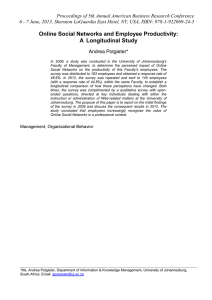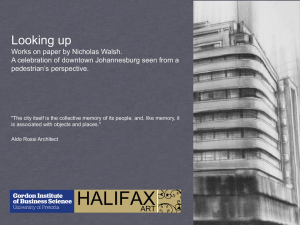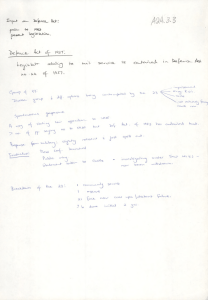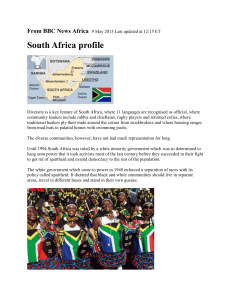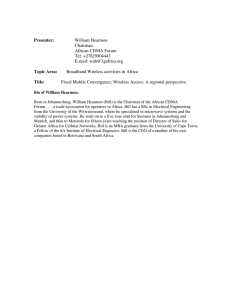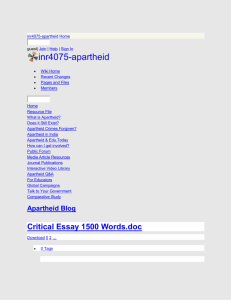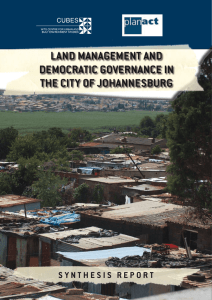2. land management in south africa
advertisement
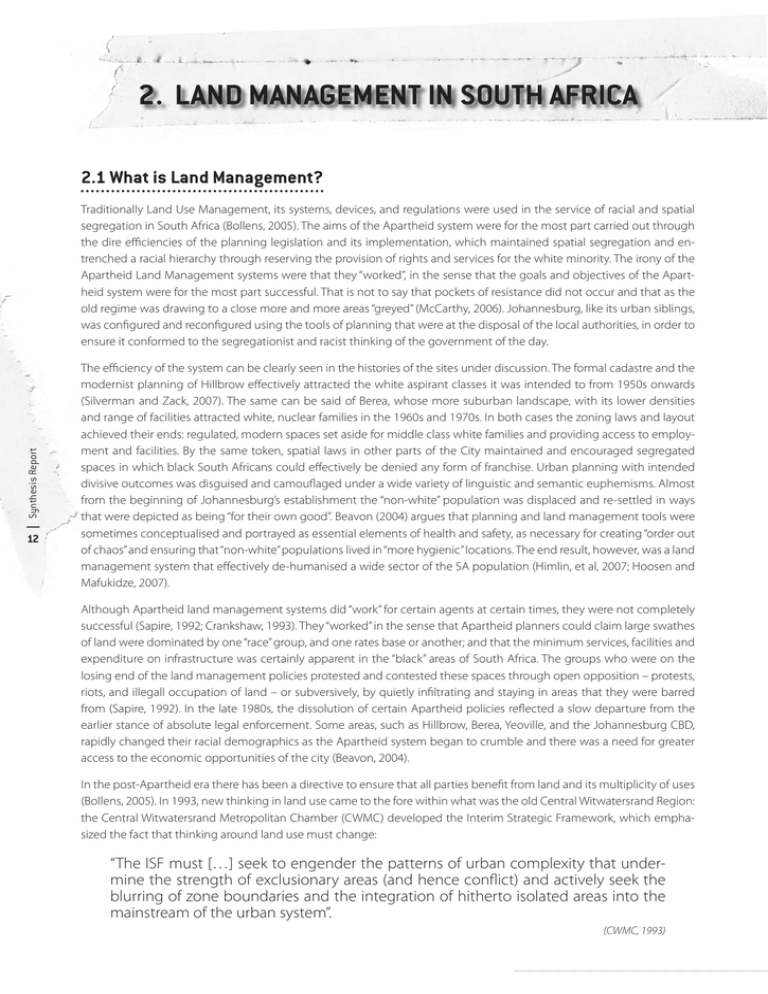
2. LAND MANAGEMENT IN SOUTH AFRICA 2.1 What is Land Management? Synthesis Report Traditionally Land Use Management, its systems, devices, and regulations were used in the service of racial and spatial segregation in South Africa (Bollens, 2005). The aims of the Apartheid system were for the most part carried out through the dire efficiencies of the planning legislation and its implementation, which maintained spatial segregation and entrenched a racial hierarchy through reserving the provision of rights and services for the white minority. The irony of the Apartheid Land Management systems were that they “worked”, in the sense that the goals and objectives of the Apartheid system were for the most part successful. That is not to say that pockets of resistance did not occur and that as the old regime was drawing to a close more and more areas “greyed” (McCarthy, 2006). Johannesburg, like its urban siblings, was configured and reconfigured using the tools of planning that were at the disposal of the local authorities, in order to ensure it conformed to the segregationist and racist thinking of the government of the day. 12 The efficiency of the system can be clearly seen in the histories of the sites under discussion. The formal cadastre and the modernist planning of Hillbrow effectively attracted the white aspirant classes it was intended to from 1950s onwards (Silverman and Zack, 2007). The same can be said of Berea, whose more suburban landscape, with its lower densities and range of facilities attracted white, nuclear families in the 1960s and 1970s. In both cases the zoning laws and layout achieved their ends: regulated, modern spaces set aside for middle class white families and providing access to employment and facilities. By the same token, spatial laws in other parts of the City maintained and encouraged segregated spaces in which black South Africans could effectively be denied any form of franchise. Urban planning with intended divisive outcomes was disguised and camouflaged under a wide variety of linguistic and semantic euphemisms. Almost from the beginning of Johannesburg’s establishment the “non-white” population was displaced and re-settled in ways that were depicted as being “for their own good”. Beavon (2004) argues that planning and land management tools were sometimes conceptualised and portrayed as essential elements of health and safety, as necessary for creating “order out of chaos” and ensuring that “non-white” populations lived in “more hygienic” locations. The end result, however, was a land management system that effectively de-humanised a wide sector of the SA population (Himlin, et al, 2007; Hoosen and Mafukidze, 2007). Although Apartheid land management systems did “work” for certain agents at certain times, they were not completely successful (Sapire, 1992; Crankshaw, 1993). They “worked” in the sense that Apartheid planners could claim large swathes of land were dominated by one “race” group, and one rates base or another; and that the minimum services, facilities and expenditure on infrastructure was certainly apparent in the “black” areas of South Africa. The groups who were on the losing end of the land management policies protested and contested these spaces through open opposition – protests, riots, and illegall occupation of land – or subversively, by quietly infiltrating and staying in areas that they were barred from (Sapire, 1992). In the late 1980s, the dissolution of certain Apartheid policies reflected a slow departure from the earlier stance of absolute legal enforcement. Some areas, such as Hillbrow, Berea, Yeoville, and the Johannesburg CBD, rapidly changed their racial demographics as the Apartheid system began to crumble and there was a need for greater access to the economic opportunities of the city (Beavon, 2004). In the post-Apartheid era there has been a directive to ensure that all parties benefit from land and its multiplicity of uses (Bollens, 2005). In 1993, new thinking in land use came to the fore within what was the old Central Witwatersrand Region: the Central Witwatersrand Metropolitan Chamber (CWMC) developed the Interim Strategic Framework, which emphasized the fact that thinking around land use must change: “The ISF must […] seek to engender the patterns of urban complexity that undermine the strength of exclusionary areas (and hence conflict) and actively seek the blurring of zone boundaries and the integration of hitherto isolated areas into the mainstream of the urban system”. (CWMC, 1993) Land Management and Democratic Governance in the City of Johannesburg Post-Apartheid thinking about land management noted that cities needed to be densified and buffer zones “infilled”, whilst upgrading and renewing areas that had previously been ignored or disregarded. To add to the challenge, all of these new land management activities were taking place in an environment where land and housing policy and legislation were being rethought and re-written (van Wyk, 1999). There were in fact many prongs to the rethinking of cities and the use of space, which impacted on land management systems. Greater emphasis was placed on secure tenure, ownership, and title both as a way of the ANC entrenching its position within the hearts of a number of the previously dispossessed (Charlton and Kihato, 2006). At the same time there was an attempt to restructure the housing and property markets, through the national housing programme and its various subsidies (McCarthy, 2006). Privatising Council housing and publicly owned land had two main objectives: the first was to make sitting tenants and people of record into property owners, with the hope that home ownership would contribute to their socio-economic upliftment. The second aim was to try and ensure that municipalities and provincial governments divested themselves of the financial drain of maintaining the stock, administering rental collection and writing off any losses due to non-payment (Morkel, 2005). There have been a number of consequences to this change in land management approaches, which have had to respond to the new directives, pragmatic and technical challenges and new international and global forces. The five case studies that were undertaken in Johannesburg offer a great deal of insight into what has happened on the ground and within the institutional environment in terms of land use management in the City. They have thrown light on a range of processes that are happening at a range of levels and with a variety of actors. What follows is an analysis of the major themes and commonalities that the studies have thrown up, followed by a series of recommendations taken from the work and its synthesis. 2.2 Current Land Use Management: An Overview One of the issues that becomes clear from the outset when examining land management in South Africa is the vast array of land use management and planning legislation. At the national level, there is an uninviting range of policy that has come to pass over the last 14 years. The wide variety of Acts include the tenets of the Constitution and its requirements and obligations regarding housing, land, property, and the principles of social justice (Ovens, et al, 2007); the Development Facilitation Act of 1995; the Housing Act (1997); Housing Code (2004); the Municipal Systems Act (2000); the various shades of papers from Green to White of Development and Spatial Planning (2001); and the Land Use Management Bill (2006)2. Each of which purports the noblest of intentions: to create urban areas that dispel and rid cities of Apartheid’s segregated planning ideals, and reconstruct cities of integration and equal economic and social opportunity (Ovens, et al, 2007). Although policy has proliferated at a national, local level and micro level, “… there has been little advancement and innovation in thinking and practice around land management, and South Africa’s towns and cities continue to develop without an adequate framework for managing land development in a way that supports the goals of democracy, equity, efficiency and sustainability” (Ovens, et al, 2007). There is a general sense that little has been done to change underlying considerations and foundations upon which legal, regulatory and policy thinking has been laid. Berrisford (2006) and Parnell (2007) both argue that the current land management systems are effectively “inimical” to many of the goals of the post-Apartheid state and are obstructive in providing the poor with access to land or supporting activities that effectively maintain and/or better their quality of life. There are other problems facing land management and, at a far more pragmatic level, there is a lack of capacity within municipalities to actually cope with land management systems. The lack of capacity occurs in two forms: the first is the 2 For a full discussion of each, please see Ovens, et al, 2007 overview report Synthesis Report South Africa’s political history has resulted in the development of urban landscapes that are enormously socially and spatially inequitable; a further significant urban feature is the existence of a number of uni-purpose nodes and settlements. Townships were essentially considered large dormitories, which intentionally lacked any business or recreational activities, and certainly no office parks. New legislation, regulation and policy had to be put in place to ensure that Apartheid cities were transformed into spaces of equity, integration, and sustainability. This meant a significant change to the way land was thought about, regulated and managed. 13 Land Management and Democratic Governance in the City of Johannesburg shortage of people with appropriate qualifications in land management to deal with the current demand. Those who are professionally qualified are often shuffled to other positions, leaving the least qualified to deal with complex policy and technical requirements for which they have neither the training nor the skill (Berrisford, 2006). The second aspect is the inability of those in the planning departments to have the time to access the newer legislation and to be trained in its application and implementation. Such training or support is frequently either unavailable or literally inaccessible to planners and land management professionals in smaller municipalities. 2.3 Land Management in the City of Johannesburg Synthesis Report Most of Johannesburg’s land policy originated in the Apartheid era. Although some policy has been added to the previous canon, the entirety has yet to be reviewed; as such the processes and patterns of land development are very similar to those of the Apartheid period. Effectively “the City of Johannesburg (CoJ) continues to apply 12 different Town Planning Schemes across the metropolitan area, each of which is rooted in outdated principles and assumptions” (Ovens, et al, 2007). The majority of the town planning applications that the CoJ processes are dealt with in terms of the Town Planning and Townships Ordinance (1985), and the remainder are processed in terms of the Less Formal Townships Establishment Act (LFTEA, 1991) and the Development Facilitation Act (DFA, 1995), both of which were designed to expedite low-income housing development in the wake of civil unrest and rapid urbanisation. 14 The CoJ with the Gauteng Provincial Government have added further policies and plans that attempt to respond to the changing demands of residents and developers, and the aims and goals of a post-Apartheid state and society. The list is extensive and includes: the Human Development Strategy (HDS), Jo’burg 2030, the Growth and Development Strategy (GDS), the Johannesburg Integrated Development Plan (JIDP), and the Spatial Development Frameworks for each Region (now designated by letters of the alphabet). Although many of the intentions in the mountainous documentation are broadly similar and some do align and slot in with each other, there is still a great deal to consider when even trying to think about land use planning in Johannesburg. The land management systems have become difficult to navigate and only the most seasoned professionals with a great deal of experience have been able to attain the land and the approval that they need. The introduction of the DFA has also meant that the City lost control over much of its planning as approval of applications in terms of the DFA are through the provincial rather than the local government structure. Thus the distinction in planning regimes between the poor and the wealthy is further, but unintentionally, supported by the provisions of LFTEA and the DFA (Ovens, et al, 2007). The planning function in the CoJ is undertaken by the Development Planning and Urban Management Directorate who at present employ about 50 town planners but could do with another 20 at least to reach their staffing requirements. The directorate is responsible for a number of functions, including land use management, planning control and enforcement, building plans, legal administration, and outdoor advertising. In spite of its vast array of obligations they are able to process about 500 applications per month, of which 2%-3% are DFA applications that require an inordinate amount of processing time (Ovens, et al, 2007). The Development Planning and Urban Management Directorate is partnered by the Development Planning and Facilitation Department who are responsible for Spatial Development Frameworks for the City’s regions. The relevant departments and staff members are stretched thin and are generally unable to devote energy, time or attention to reviewing current land management policies or coming up with creative ways of addressing obstacles and issues within the current policy (Ovens, et al, 2007). Having said that the City is not unaware of the challenges it is facing. By way of illustration, the City is making substantive attempts to address the historical disinvestment in the Johannesburg CBD by proactively engaging in a range of inner city innovations, as well as seeking to compact the City and control the north and north-westward expansion through the Urban Development Boundary. It is also engaged in the large scale Alexandra Renewal Project and has recently set its sights on the suburbs surrounding the inner city. At the same time, the City has taken on board critiques of its housing programme and the peripheralisation of low-income communities in housing developments on the urban edges. Encouragingly the recognition of these issues is leading to discussions with parastatals, private land owners as well as other public entities around the provision of well-located land for low-income and affordable housing. The question of how that land is proclaimed, zoned and finally regulated remains one of the key issues to be considered. Synthesis Report 15 Top left: Dilapidated apartment building, Hillbrow Top right: High density living of multi-storied apartment blocks, Hillbrow/Berea Middle left: Informal settlement along floodline area, Diepsloot Middle right: Freedom Charter Square informal settlement and Walter Sisulu Square of Dedication, Kliptown Bottom left: Informal chicken trading, Hillbrow lane Land Management and Democratic Governance in the City of Johannesburg Top left: Narrow refusefilled alleyways, Hillbrow / Berea Top right: Informal trading, Diepsloot Bottom left: Informal and formal trading, Kliptown Synthesis Report Bottom right: RDP house, Diepsloot 16 Synthesis Report 17 Top left: Informal settlement along floodline, Diepsloot Top right: Freedom Charter Square informal settlement along railway line, Kliptown Bottom left: Informal trading, Fourways Bottom right: Freedom Charter Square informal settlement, Kliptown Synthesis Report Land Management and Democratic Governance in the City of Johannesburg 18 Top left: Walter Sisulu Square of Dedication, Kliptown Top right: Informal street trading, Quartz Street, Hillbrow Middle left: Freedom Charter Square, Kliptown Middle right: Rental units, Kliptown Bottom left: Social Housing Units, Kliptown
